Last updated: July 2, 2025
Article
Conserve O Gram 9/1: Fatty Acid Spew on Leather Objects

It became common in the 19th and early 20th century to use leather dressings on aged leather objects (including books, horse tack, knapsacks, jackets, etc.) in museum collections as a routine preventive measure as well as interventive treatment. Products such as Neatsfoot oil, British Museum Leather Dressing (sometimes referred to as “BMLD” in old conservation reports), Saddle Soap, and Pecard Leather Dressing were applied by collection caretakers in an attempt to slow deterioration, improve the appearance of the leather, and perhaps restore some of its former strength and flexibility. Although the actual outcome rarely met those goals, the applicator often had the feeling that they did something to preserve the material. Today we understand that sometimes doing nothing is the best course of action for the longevity of an object.
The passage of time has proven that the addition of dressings, especially as a frequent routine measure, has contributed to condition issues that collection staff and conservators must deal with now, namely the oily and darkened appearance of the leather, embrittlement, and the growth of a white waxy substance called fatty acid spew (or “spue”) on the surface that is commonly mistaken for mold (Knuutinen and Sallas 2005, Perkins 2010, Burton 2020).
Research on Leather Dressings
The effects of dressings on leather permanence have long been studied, and researchers concluded nearly 100 years ago that dressings have no preservative effect (Wallace, Critchfield and Beek 1935, Smith 1964). For example, one study found that chestnut-tanned leather treated with a dressing made of sulphonated cod-liver oil deteriorated faster than leather without dressing (Wallace, Critchfield and Beek 1935). The British Leather Manufacturers Research Association found in a long-term study that the absence of a dressing did not make the leather more prone to decay (i.e. dressings do not protect leather) (Elliott 1969).Despite knowing for decades that dressing do not impart long-term stability to the leather, caretakers continued to apply them through the 20th century. Indeed, even the first publication of this Conserve O Gram in 1993 presented research on the inefficacy of dressings, yet the pamphlet was titled “Leather Dressing: To Dress or Not to Dress”. This title suggested ambiguity over whether one should apply leather dressing, while the answer in the text was resounding “no”. Figure 1 shows a pair of children’s shoes from the 19th century that were treated in 1978 at Harpers Ferry Center. The Treatment Report discusses the process:
“Tried unsuccessfully to restore flexibility to the leather by soaking one [shoe, on the right in Figure 1] in an alcohol and NeutralFat SSS (a stabilized olein soap) solution [e.g. a leather dressing]. The stitching attaching the sides to the sole were weakened and broke, the parts of the shoe becoming separated, and the color darkened. The fabric lining also became very weak and looked as if it were about to disintegrate. The parts were removed and allowed to dry. The excess NeutralFat was wiped off. No further treatment was given. The other shoe, the one with the string lace [on the left, in the image], was merely coated on the outside with BMLD [British Museum Leather Dressing] brushed on and rubbed in, in several applications. There was only a slight darkening but no increase in flexibility."
The conservator noted that dressings were not applied to other leather objects in the project since they not only failed to improve the leather, but they also contributed to the deterioration of the shoes.
A group of leather conservators at the International Institute for Conservation (IIC) annual meeting in 1982 discussed popular contemporary leather treatment methods and found no outstanding successes with the use of dressings on historic collections (“Leather Meeting at IIC”). Eventually, observing the consistent negative ramifications of leather dressing caused a shift in the museum field, steering away from its application and focusing instead on preventive care (Kite, Thomson, and Angus 2006, Carrlee 2012, Burton 2020). Today it is rare for dressings to be applied during conservation treatment and its use is not advised as a preventive measure (Perkins 2010).
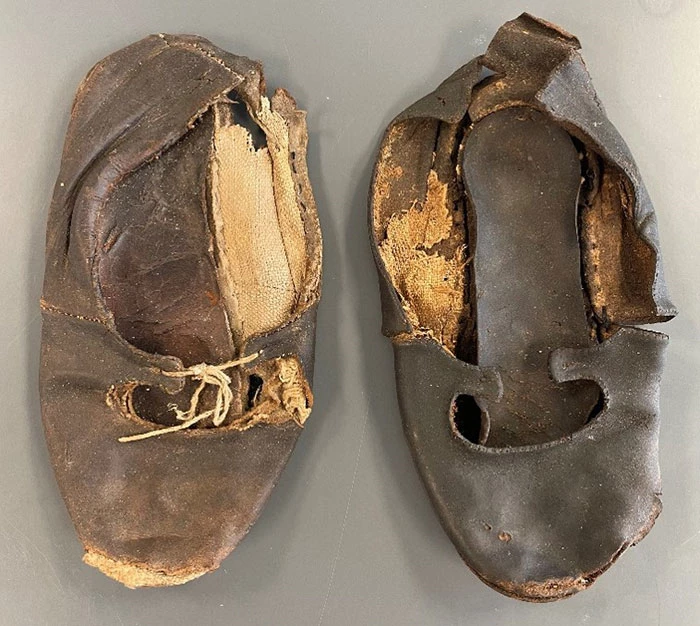
New Problems Created
In practice, applying a dressing to leather is an irreversible procedure because of the deep penetration of the foreign ingredients and the subsequent movement of their soluble components within the leather matrix. The dressing can also impede future conservation treatments such as tear repair because adhesives tend to stick poorly to oily or waxy surfaces.
The instability of the fats and/or oils in the dressing, the waxy additives, and harsh solvents can be responsible for numerous undesirable and unexpected effects.The oil and fat components of dressings can:
- form unstable surface spew – a white bloom covering the surface.
- become increasingly acidic.
- turn rancid and create a putrid smell that cannot be reversed.
- oxidize and stiffen the leather.
- harm adjoining materials.
- cause waxy green copper stearates and copper oleates.
- leave a sticky surface (Figure 2).
- discolor and stain the leather (Figure 3).
- encourage biological growth/deterioration.
Waxy additives in dressings can:
- block surface porosity.
- discolor and collect dust.
- change the surface appearance.
- impede further treatment.
- encourage biological growth/deterioration.
Solvents in dressings can:
- wet and swell the leather.
- dissolve and/or dislocate original components.
- affect surface finishes such as dyes.
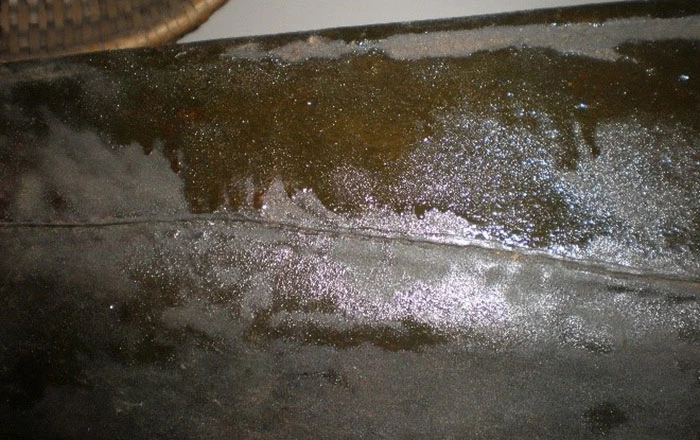
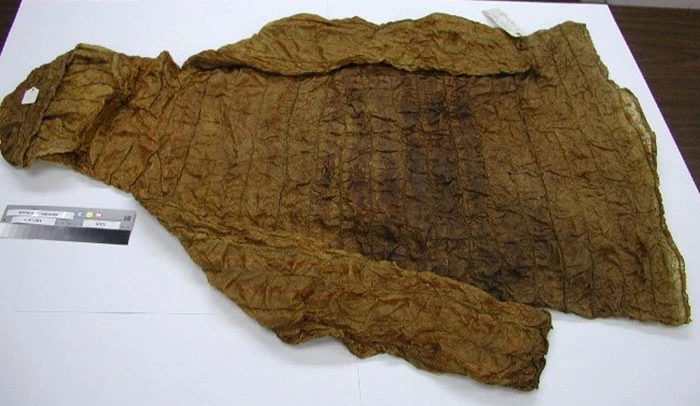
White Bloom: Fatty Acid Spew
The most prominent and prolific problem created by leather dressings is the development of a waxy white bloom on the surface of leather, referred to as fatty acid spew (Figure 4). The spew is caused by the migration of free fatty acids that were not removed from the dressing during its manufacture (Tuck 1983, Burton 2020).
How to Identify
Over time the free fatty acids become solids that exude to the surface of the leather (in a similar way olive oil in salad dressing will solidify in cold temperatures). Under slight magnification the spew can be described as fluffy moss, small snowballs, or white broccoli heads. When touched it feels soapy or waxy, and when a sample is heated with a hair dryer, it will melt (Figure 5).
Dressings were applied to many types of leather objects that required flexibility while in use, especially to horse tack, utilitarian objects, and leather books. If a bright white bloom is developing on saddlery (Figure 6) or other such objects, and there has not been a water event or rise in humidity above 65% relative humidity (RH), chances are good that the substance is fatty acid spew.
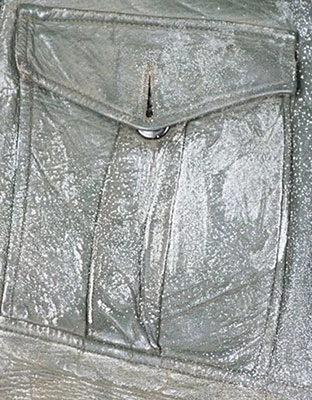
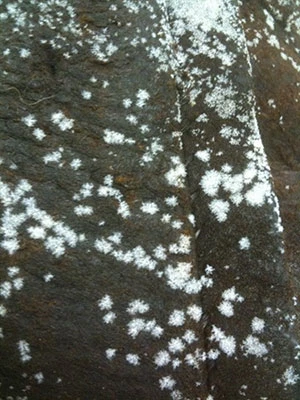
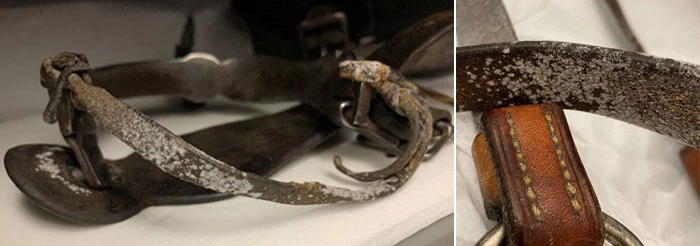

Other White Blooms and Impacts on Aged Leather Appearance
It can be difficult to distinguish between fatty acid spew and other white blooms on leather, even for conservators who have worked on leather objects for many years. Images alone may not be sufficient, and the object must be studied in person, as well as the historical context of the object and the environmental parameters surrounding its use and storage. The following are a list of other white blooms that may be present in addition to or instead of fatty acid spew.
Mold
Fatty acid spew is often confused with mold, which may also appear as a light-colored fluffy growth on the surface of organic objects (Figure 8). Examination under magnification is necessary to conclusively identify substances. Mold growth has a branched, soft or fuzzy appearance, sometimes with less defined edges (Figure 9). Fatty acid spew has localized growth that is opaque with defined edges that looks similar to waxy frost, broccoli heads, or puffballs. If the mold is actively growing, then moving it from high RH to low RH will cause it to become inactive and shrivel. If there is no change in appearance when the object is placed in low RH (below 50%), chances are it is spew and not mold.
Many bacteria and fungi feed on animal fats and thrive in humid conditions. Dressings can trap moisture in the fibers of the leather and create the ideal environment for mold, meaning objects can develop both mold and fatty acid spew (Figure 10).


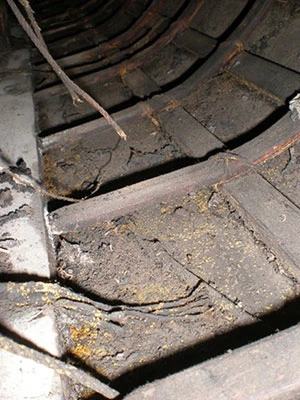
Fatty acid spew may also be mistaken for salt. Leather is a tangle of collagen fibers, making it generally porous and absorbent. Soluble salt from the sweat of draft animals and humans may have been driven into the leather during the original use of the objects. Maritime objects exposed to the sea can retain salts. Museum objects may have been recovered from outdoor settings, such as barns, where they absorbed salt and moisture from the ground before being placed in storage (Figure 11). An accumulation of salt may be visible as a faint white or light-colored irregular tideline, where it penetrated the leather and then dried. Embedded dirt and dust can produce an overall hazy lighter-colored surface that is not easily removed (Figure 12).


Residual pesticides applied to organic materials in museum collections in the 19th and 20th centuries may also migrate to surfaces in the form of light powders and crystals, such as mothballs (naphthalene or paradichlorobenzene) or arsenic. Because of the potential for human health issues, consult with a conservator before handling an object if it is unclear whether the substance is fatty acid spew or an old pesticide (Figure 13). See Conserve O Gram 2/3 Arsenic Health and Safety Update for more information.

White growths and particulates on leather objects may also be the result of a wide variety of substances and circumstances, ranging from deodorant transfer or food residues, to polishing compound residue deposited from adjacent brass components (Figure 14). When in doubt, take a photograph of your white bloom and send it to a conservator for help in identification.
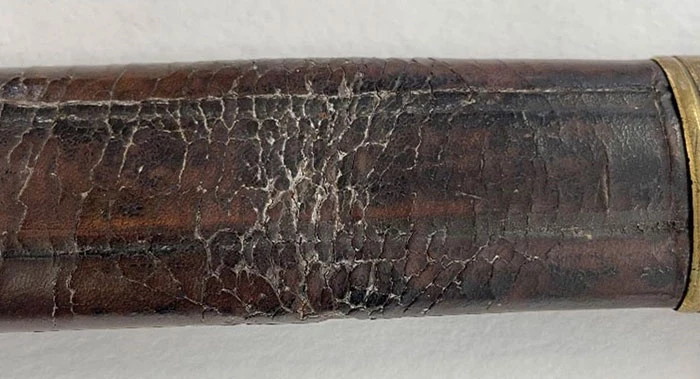
Fatty acid spew can be reduced from the surface but can never be removed fully and safely from the collagen fibers of the leather, and it will likely return over time as it did in five years’ time on the green jacket in Figure 15. If there is confirmed fatty acid spew, brush it off the object with a soft bristle brush (natural or synthetic hairs) into the nozzle of a vacuum that is held a couple inches above the surface of the object. If the bloom smears while brushing and active mold is suspected instead, seek guidance from a conservator for help troubleshooting next steps.
Further cleaning can occur after seeking guidance from a conservator to ensure the leather and leather finishings are structurally stable. Cotton swabs dampened with ethanol or odorless mineral spirits can dissolve the spew from the surface but may also cause damage on some leathers. For example, repeated solvent treatment to remove fatty acid spew from the green leather coat in Figure 15 could result in the diminishing of the green dye. Although the heat from a hair dryer can dissolve and re-embed the fatty acid spew, it may also cause the leather to shrink.

When Dressings are Acceptable
While the application of a dressing is no longer considered best practice for routine preservation of leather objects in collections, there may be instances when substances are applied by the source community members to maintain cultural practices. Information regarding traditional care practices should be recorded and maintained with the object. Some conservation treatments might need the use of small amounts of dressings to impart temporary flexibility to leather, such as leather-bound books that require opening and closing to access text.Application of leather dressings for personal (non-museum) objects is also acceptable if these objects must still function for their intended use, such as leather work boots, baseball gloves, and horse saddles. However, once items are cared for in a controlled museum environment, the long-term risks from dressings outweighs the short-term gain in flexibility. Dressings are beneficial for the useful life of an object, but over time there are diminishing returns. Previous application does not merit continued application because negative results are exacerbated. Museums rely on preventive conservation measures to care for collections, such as maintaining stable RH and temperature, using inert materials to pad objects and provide internal support, and routinely cleaning storage spaces (Perkins, 2010).
Conclusion
Dressings and fatty substances cannot be removed fully from leather objects. Further research in the field is required to understand the exact environmental parameters needed to slow the formation of fatty acid spew. For now, caretakers of leather objects should refrain from dressing leather and follow the preventive care guidelines outlined in NPS Museum Handbook, Part I, Appendix S: Curatorial Care of Objects Made From Leather and Skin Products (nps.gov)Selected References
Burton, Marci Jefcoat. “All Dressed Up: A study of stearate growth occurring on Anne Morrow Lindbergh’s leather flight helmet.” Smithsonian National Air and Space Museum blog. 22 December 2020.Carrlee, Ellen. “Top 13 Reasons Why We Don’t Use Leather Dressings at the ASM.” Alaska State Museums Bulletin, 58. November 2012.
Elliott, R.G.H. “Long-term Durability Test for Bookbinding Leathers: A Review.” Journal of the International Society of Leather Trades Chemists 53: 309-317. 1969.
Kite, Marion, Roy Thomson and Aline Angus. “Materials and Techniques: Past and Present” In, Conservation of Leather and Related Materials. Edited by Marion Kite and Roy Thomson. London. Butterworth-Heinemann, pp. 121-129. 2006.
Knapp, Anthony M. “Arsenic Health and Safety Update.” Conserve O Gram 2/3. Washington, DC. National Park Service. 2000.
Knuutinen, Ulla, and Laura Sallas. “Leather Spue: a Problem with Lubricants.” ICOM Triennial Meeting (14th) Preprints, 249-254. September 2005.
“Leather Meeting at IIC.” Abbey Newsletter, 6. October 1982.
National Park Service. Museum Handbook, Part I. Appendix S: Curatorial Care of Objects Made from Leather and Skin Products
Perkins, Beverly Nadeen. “Don’t Lather that Leather: Tips from Our Conservator.” Points West, Buffalo Bill Center of the West, 12. Winter 2010.
Smith, Richard Daniel. Preservation of Leather Bookbindings from Sulfuric Acid Deterioration. MA paper, University of Denver, 1964.
Tuck, D.H. “Oils and Lubricants Used on Leather.” Northampton: The Leather Conservation Centre, 18. 1983.
Wallace, Everett L., Charles L. Critchfield, and John Beek, Jr. “Influence of Sulphonated Cod-liver Oil on Deterioration of Vegetable-tanned Leathers by Sulfuric Acid.” Journal of Research of the National Bureau of Standards 15:73-77. 1935.
Fran Ritchie, Objects Conservator
Kyle Bryner, Conserve O Gram Coordinator and Editor
Museum Conservation and Collections
Harpers Ferry Center, National Park Service
Ellen Carrlee, Conservator
Alaska State Museum Juneau, Alaska
Formerly issued as Conserve O Gram 9/1 Leather Dressing: To Dress Or Not To Dress
Toby Raphael (1993)
Objects Conservator
Published January 2025
The Conserve O Gram series is published as a reference on collections management and curatorial issues. Mention of a product, a manufacturer, or a supplier by name in this publication does not constitute an endorsement of that product or supplier by the National Park Service. Sources named are not all inclusive. It is suggested that readers also seek alternative product and vendor information in order to assess the full range of available supplies and equipment.
The series is available on the National Park Service Museum Management Program's website.
